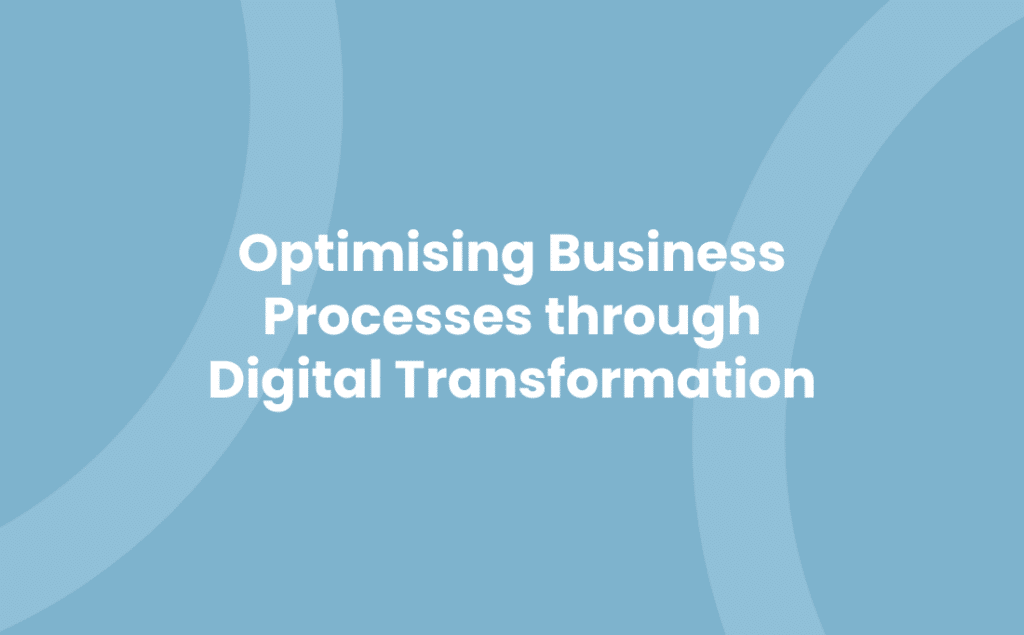In the digital age, the landscape of business is ever-evolving. As you navigate through this terrain, you’re likely to encounter the term ‘Digital Transformation’. But what does it really mean? And how can it optimise your business processes?
Digital Transformation isn’t just a buzzword. It’s a strategic approach that harnesses the power of technology to revolutionise business operations. With an optimised process, you’re not just keeping up with the times, you’re staying ahead of the curve.
Get ready to delve deeper into the world of Digital Transformation and discover how it can streamline your business processes, boost efficiency, and propel your organisation towards success. Buckle up, because we’re about to take a fascinating journey into the future of business.
Understanding Digital Transformation
Embrace the essence of Digital Transformation: it’s a strategic overhaul rather than a mere buzzword. In the business sphere, the call for digitisation isn’t about jumping on a tech bandwagon. Rather, it’s about revolutionising your operations with a smart symbiosis of technology and strategic planning for optimized results.
Take, for instance, process optimisation, an integral facet of Digital Transformation. Here, technology works as catalyst, streamlining processes, trimming inefficiencies, and enhancing the functional efficiency of your operations. With such well-thought-out integration, you won’t just stay afloat in the turbulent waters of your industry, but easily sail towards organisational success.
But, it’s not just about technology injection into your business. Digital Transformation is far more encompassing. It encourages a cultural shift in your business, compelling all stakeholders from top management to frontline employees, to re-envision traditional business models. Working together, they create more dynamic strategies, fuelled by technology, that breathe fresh life into stagnant processes.
Moreover, the efficiency gains from Digital Transformation extend beyond merely speeding up processes or reducing operational costs. It moulds your business to be adaptable in fostering an environment that encourages continuous learning and innovation. Essentially, digital business optimisation provides the tools for your organisation to proactively adapt and evolve in your industry landscape.
See, true Digital Transformation transcends technical implementation. It’s a strategic approach to optimising your business processes, empowering you to rise above the competition. You’re not just implementing technology, you’re transforming your business with it. Understand this, and you’re well on your way to harnessing the full potential of Digital Transformation.
The Relationship Between Digital Transformation and Business Process Optimisation
Digital transformation and business process optimisation, when intertwined, unveil a synergy that bolsters operational efficiency and invigorates strategic planning. This correlation arises from the pervasive influence of technology, primarily digital platforms, within your organisation’s operational structures. By streamlining complex processes, you concurrently establish a bedrock for digital transformation.
Intertwining digital transformation with process optimisation affords considerable merits. Firstly, it introduces automation, seamlessly allotting routine tasks to digital solutions. For example, adopting applications with machine learning capabilities expedite decision-making processes, avert potential bottlenecks and mitigate errors.
Secondly, digital transformation explicates data-powered insights. Organisations often sit on mounds of unstructured data. By digitalising your workflow, you’re well-equipped to translate this data into actionable intelligence, harnessing its latent potential. Augmented by cloud computing, these insights bear key implications on your strategic, operational, and tactical objectives.
Thirdly, it accelerates product or service delivery, echoing directly on customer satisfaction. In a digitally driven market, customers anticipate swift, impeccable services. By optimising your business processes through digital transformation, you meet client needs efficiently, capitalising on the digital transformation process optimisation.
Lastly, it fortifies employee productivity. Implementation of digital tools absolves employees from mundane, repetitive tasks, empowering them to focus on more critical, cognitively demanding roles, thereby enhancing overall productivity.
In the digital business optimisation journey, an integrated approach to digital transformation and business process optimisation proves pivotal. Understand, it’s not a singular act, but a sustained endeavour, a strategic cultural shift. It requires constant monitoring, evolving in tandem with technological changes, thus leaving an indelible mark on your organisational success.
Key Components of Digital Transformation for Business Process Optimisation
Embarking on a digital transformation path involves essential components for effective business process optimisation. These components play significant roles in ensuring your business effectively aligns its strategic goals with operational efficiency.
1. Integration of Technology: One of the key factors in digital transformations, integration prompts smooth cross-functional interactions in your organisation. Imagine the convenience when all the systems and software collaboratively work, sharing data and insights, that would otherwise require many manual steps.
2. Process Automation: Utilising automation, organisations eliminate manual, repetitive tasks, saving time, and improving productivity. For example, automate data entry, and you’ve drastically reduced hours of menial tasks.
3. Data Analysis: Sharp decisions are an outcome of robust data analysis. Gathering from various sources, this data translates into actionable insights. Numeric reports, such as sales figures or customer retention rates, can guide your business strategies.
4. Cybersecurity Measures: With digital transformation comes the responsibility to ensure data protection. Cybersecurity defences protect your assets from potential threats and unauthorized access.
5. Employee Training: An understanding of new software and systems is essential. Employees armed with knowledge and skills can leverage technology to deliver optimal performance and service.
6. Continuous Improvement: Businesses striving for process optimisation learn, adapt, and evolve. Keep updating and fine-tuning procedures for continued efficiency.
7. Agile Methodologies: Implementing Agile methodologies enables teams to work in harmony, promoting experimentation, learning, and speedy delivery.
8. Use of Cloud Services: Cloud services provide flexibility and scalability. It allows safe data storage and sharing within a network.
These key components, when combined, lead to successful digital transformation process optimisation. However, remember digital business optimisation is not a one-off task. It’s an ongoing journey, where businesses need to consistently re-evaluate their processes and adapt to new changes.
Approaches to Effective Digital Transformation Business Process Optimisation
Opting for an Agile Approach, a common choice, promotes adaptability on your journey towards optimising business processes through digital transformation. It focuses on iterative progress and flexibility, perfect for tweaking strategies in real-time based on accumulated data.
Secondly, harnessing the power of Lean Methodology may present a potent opportunity for digital business optimisation. Lean zero-ins on waste reduction and streamlining processes to deliver value more efficiently to your customer. With this, you’re not only refining the quality of output but also fostering a thriving environment of continuous process improvement.
Further, the application of Six Sigma, coupled with Lean principles, precisely pinpoints areas in need of improvement. Through rigorous statistical analysis, inconsistencies and defects in your business process get identified and effectively addressed, boosting the standard of your output.
Another method is Business Process Re-engineering (BPR). By breaking down existing systems and re-building them from ground-up, BPR aims to entirely restructure your business processes. This approach allows you to examine established processes and implement radically innovative changes, thus driving transformative results.
Introducing Decentralised decision-making empowers those closest to the task. By allowing these individuals to make decisions, you’re fostering a culture of responsibility and efficiency.
Finally, the construct of a Business Transformation Office (BTO) can provide direction, monitor progress, and manage communication throughout your digital transformation process optimisation efforts.
Selecting the appropriate method relies on your business goals, environment, and your team’s capabilities. Therefore, incorporating an accurate mix of these approaches can drastically enhance your process optimisation efforts, enabling your business to reap the full rewards of a digital transformation.
Real-life Examples of Digital Transformation Business Process Optimisation
Reflect on the transformative power of digital technology by exploring some real-world instances where digital transformation process optimisation has drastically improved business operations.
- Amazon’s Inventory Management: Amazon leverages advanced analytics combined with machine learning. It results in improved decision-making in areas such as demand forecasting, scaling, and inventory replenishment. Through enhanced digital business optimisation, Amazon effectively reduces waste while increasing speed and efficiency, ensuring customers’ orders arrive accurately and promptly.
- Procter & Gamble’s Decision-Making: Proctor & Gamble adopted a solution powered by artificial intelligence and machine learning. It’s allowed for predictive modelling, forecasting, and in-depth analysis, improving organisational decision-making. By capitalising on digital transformation process optimisation, Proctor & Gamble have significantly increased their operational efficiency and agility.
- Starbucks’ Customer Experience: Starbucks, the global coffee chain, has expertly utilised digital transformation to reinvent their customer experience. Using their digital app, they’ve streamlined the ordering and payment processes, personalised rewards and digital marketing campaigns, and integrated AI technology for suggestions and feedback. This digital business optimisation has revolutionised Starbucks’ customer interactions while bolstering their bottom line.
- Airbnb’s Business Model: Airbnb’s entire business model is a prime example of digital transformation in action. By creating a platform that seamlessly connects homeowners and travellers worldwide, Airbnb disrupted the traditional hospitality industry. They continue to optimise their processes through constant updates and enhancements, ensuring a smooth and effortless experience for their users.
- Coca-Cola’s Supply Chain: The beverages giant, Coca-Cola, transformed its supply chain with AI and machine learning. It’s resulted in predictive maintenance, real-time inventory management, and quicker, more efficient deliveries. By harnessing digital transformation strategies, Coca-Cola has trimmed its operational costs and fulfilled customer demands in a more timely manner.
Remember, digital transformation isn’t just about adopting new technologies. It’s about revolutionising your business processes, and as you can see from the examples above, when it’s done right, it can yield substantial improvements.
Overcoming Challenges in Digital Transformation Business Process Optimisation
Traversing the path of Digital Transformation Business Process Optimisation (DTBPO) isn’t always a smooth journey. You could face formidable obstacles that could pose threats to successful implementation. Let’s unpick some of these challenges and suggest potential solutions.
- Resistance to Change: Often, employees show resistance to new technologies or processes, making the DTBPO journey difficult. Creating a change-friendly culture is a strategic move. Engage employees early, involve them in decision-making, provide necessary training and support to ease the process.
- Data Privacy and Security: Digitalisation brings the challenge of protecting sensitive data. Robust security measures and clear data governance strategies are required. Regular audits, encryption, multi-factor authentication, and adhering to global standards like GDPR can enhance security, reducing risks.
- Choosing the Right Technology: Identifying the correct digital solution that aligns with your business objectives is critical. Extensive research, considering factors such as cost, functionality, scalability, vendor support, and user experience can guide the selection process.
- Lack of Digital Skills: With the advent of digitalisation, a scarcity of skilled resources often occurs. From an organisational perspective, investing in regular training sessions, or partnering with digital experts can help bridge the necessary skill gap.
- Inconsistent Process: Standardisation of business processes is essential for DTBPO. Using tools like Process Modelling and Enterprise Architecture helps create a visible, consistent, and controlled business process.
- Integration Issues: Often, integrating new digital technologies with existing infrastructures can be challenging. Adopting flexible technology platforms that can seamlessly blend with your current setup can resolve these hitches.
These challenges can indeed be daunting. However, with efficient strategies and effective planning, you can navigate this digital transformation process optimisation journey with finesse. Embrace these challenges as stepping stones towards your progressive digital journey and turn them into opportunities for digital business optimisation.
Future Trends in Digital Transformation and Business Process Optimisation
Look to the horizon of business technology and you’ll see several emerging trends set to redefine the world of Digital Transformation Process Optimization. Several businesses grasp the transformative power of digitisation and its role as the engine driving Business Process Optimisation. Let’s delve into the key trends poised to shape the future.
Artificial Intelligence (AI) and Automation take the pole position. AI intervenes to make sense of vast amounts of data. For instance, it filters unnecessary noise out of your customer demographics, aiding in the creation of targeted marketing strategies. Automation, on the other hand, eliminates repetitive tasks, freeing up time for your workforce to focus on core business activities. The combination of these technologies, known as hyper-automation, brings even better outcomes.
Next comes the Internet of Things (IoT), transforming everyday objects into smart devices. It aids digital business optimization by ushering operational efficiency and effectiveness into organisations. For example, smart sensors in a manufacturing facility can predict machine failures, paving the way for preventive maintenance and averting expensive downtime.
Data Analytics also contributes enormously to future trends. Businesses harness the power of data to derive insights and make informed decisions. Modern data analytics tools offer capabilities that range from predictive to prescriptive analytics, enabling companies to forecast future trends and make optimal choices.
Next up, Digital Twins or virtual models of physical entities or processes, they add a vibrant layer to the digital transformation process optimization. They help companies to test different scenarios and find the most profitable course of action.
Lastly, Agile and DevOps cultures continue to gain momentum. They promote quick responses to changes in the business environment and give emphasis to constant communication between development and operations teams, heralding a new era of streamlined business processes.
As we move further into the digital age, the role of these technologies becomes increasingly paramount. To stay competitive, it’s essential to embrace these trends and incorporate them into your digital and business process optimisation strategies. Remember, it’s a journey, not a destination. The future of digital transformation lies in continuous learning, adapting, and innovating.
Conclusion
Digital Transformation and Business Process Optimisation aren’t just buzzwords. They’re the driving forces behind today’s most successful companies. By harnessing the power of digital tools and optimising business processes, you’re making a strategic choice to innovate, streamline and stay ahead in this digital age. Whether it’s Agile, Lean, Six Sigma, or Business Process Re-engineering, you’ve got a plethora of methodologies to choose from. With the likes of Amazon and Coca-Cola leading the way, there’s no shortage of inspiration. As we look to the future, the importance of AI, Automation, IoT, Data Analytics, Digital Twins, Agile and DevOps cultures cannot be overstated. These trends are not merely reshaping business technology; they’re rewriting the rules of the game. It’s clear that to thrive in this digital landscape, continuous learning, adaptation, and innovation are non-negotiable. So, are you ready to take the leap?


